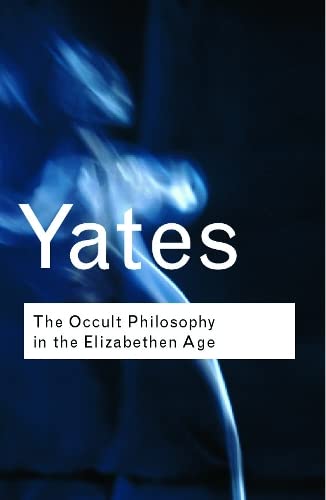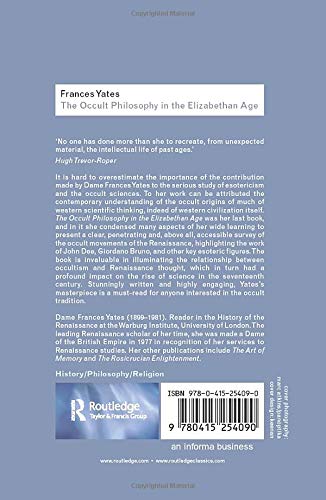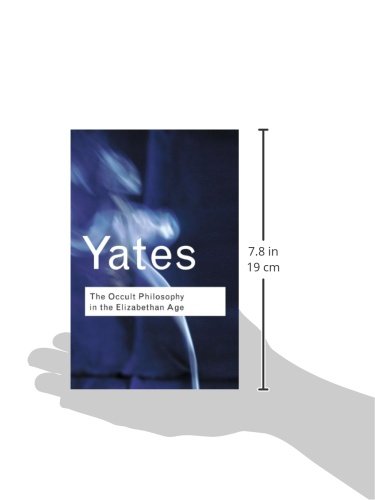Customer Services
Copyright © 2025 Desertcart Holdings Limited
Desert Online General Trading LLC
Dubai, United Arab Emirates




The Occult Philosophy in the Elizabethan Age (Routledge Classics)
T**L
interesting
I don't know. I was thinking that they would give me an over all picture of the influence of the occult in the Renaissance . What was the over all influence? Maybe on second reading I would get this but on first reading it was about four or so occult figures of that time. It was still kind of interesting. A negative for me was the descriptive “Christian Kabbalah.” The idea seems to be that they rewrote certain parts of the Kabbalah to make the name jesus the highest name of magic, and that these folks practiced the “very whitest magic,” but I am not sure this would qualify as “Christian.” Also, out of a 220 page text she used this descriptive in my estimation easily over 700 times. Toward the end it became annoying.
I**E
Lucidly written, classic introduction (3.7 stars)
to the philosemitic "Christian Cabala" (henceforth C.C.) component of Renaissance Neoplatonism and its role in shaping the undercurrent of Elizabethan zeitgeist. The aim of this movement of new learning, argues the famous Warburg scholar, was to achieve "universal harmony" creating a "powerful philosophy" that supersedes scholasticism, and to proselytize Jews (and Muslims), for instance, through the use of gematria to prove that Jesus was the name of the Messiah, etc.The study starts with an overview of the ideas and/or works of influential thinkers, including the 13th century Catalan Ramon Lull as a forerunner, Florentians Ficino and Pico, the Venetian Franciscan Giorgi/o, Germans such as Reuchlin and the itinerant Agrippa, plus Dührer (part I pp. 9-84): 3 worlds - terrestrial/elemental, celestial/planetary, supra-celestial/angelic; 3 stages of "inspired melancholy" leading to visionary trance/insights (on the apropos of Dührer's engraving 'Melencolia I') closely connected to the revalued implications of Saturn(ian religion - building on Saturn and Melancholy: Studies in the History of Natural Philosophy, Religion, and Art by Klibansky - Panofsky - Saxl, 1964); refutation of demonic influence on the basis of C.C. having been cleansed and functioning as "white magic" (see the accusations levelled against John Dee, for example). Unfortunately, Dame Yates does not go back to the roots, hence does not examine the place of Kabbalah in Judaism - the acceptance of which, much less its practice, has never been unequivocal among Jews themselves, especially not since the appearance of Lurianic K. in the 16th century - elsewhere I've come across the curious yet unverified theory that Isaac Luria Ashkenazi from Ottoman Palestine had been an admirer of the Jesuit founder.Part II (pp. 85-192): the Sidney circle; life and works of mathematican, occultist conjuror John Dee - "one of the creators of British imperial legend" (p. 109). Nowhere does the author mention that Dee may well have been the Queen's secret agent undersigned 007 (he was an expert on cyphers/cryptography, too); Elizabeth I "as a Neoplatonic heroine" in E. Spenser's The Faerie Queene (also Cynthia - Venus imagery); "inspired melancholy" attested in G. Chapman's "Shadow of Night"; sketchy analysis of a few Shakespearian plays from old-new perspectives (Merchant of Venice, King Lear, The Tempest) - bear in mind Yates was a Stratfordian; so forth..."The Giorgi influence must somehow have merged with an Arthurian-British element to form a kind of 'British Israel' mystique. Such a linkage would be quite possible in the highly charged atmosphere of sacred destiny, of religious mission [Protestant evangelism], with which Elizabethan Englishmen maintained their morale in their dangerously isolated position [versus Catholic Counter-Reformation]" (p. 122).Furthermore, "[t]he legend [of the marrano siblings Manuel Lopez Pereira and Maria Nunez's visit to England in 1593]...would make sense as allegory of philosemitic tendencies in the English queen, of a Jewish spiritual beauty associated with that of the reformed Imperial Virgin" (p. 133).Part III (193-218): Elizabethan revival under Prince Henry (died 1612, son of James I) - notes on Rosicrucianism; "constructive Hebraism of the Baconian movement" (p. 205) towards a C.C. utopia as envisioned in Sir Francis Bacon: The New Atlantis (refering to a would-be America, imho):"And for the country of Bensalem [in New Atlantis], this man [the Jew] make no end of commending it, being desirous by tradition among the Jews there to have it believed that the people thereof were of the generations of Abraham, by another son...and that Moses by a secret cabala ordained the laws of Bensalem which they now use, and that when the Messiah should come, and sit on his throne at Jerusalem, the King of Bensalem should sit at his feet..."Spenser's messianic monarchic epic of chivalrous theme transformed into Puritan messianism of a republic with biblical properties by Milton (see Jeffrey S. Shoulson - "Milton and the Rabbis," 2001 Columbia UP); preparation for the Jews' return to England by Menasseh ben Israel of Amsterdam during Cromwell's reign.Another thread of importance running through the discussion lists certain figures labeled as "reactionary, anti-Cabalist, or antisemitic" (although this latest term was coined in 1879 by the German Wilhelm Marr): converso Pfefferkorn (contra Reuchlin et al.) for warning against the Talmud and the Christian endorsement of Kabbalah - in today's judeophile PC parlance he would be called a self-hating Jew (for details see pp. 623-36 in Michael A. Hoffman II's Judaism Discovered: A Study of the Anti-Biblical Religion of Racism, Self-Worship, Superstition and Deceit , 2008 Independent History and Research); the French Jean Bodin's veiled attacks on Pico and Agrippa in On the Demon-Mania of Witches (Renaissance and Reformation Texts in Translation, No. 7) (1580) for "their wrong use of Cabalist magic" (p. 81) in times of witch craze; anti-Empire Marlowe's criticism of Dee and the Jews (Doctor Faustus, The Jew of Malta); Ben Jonson's satirical play "The Alchemist" ridiculing occultism; and Marin Mersenne's strong disapproval of key Renaissance thinkers (pp. 201-3).Epilogue (219-22), informative endnotes/bibliographical references (223-44), incomplete index (245-55). To my slight dismay, the prestigious publisher seems to be content with the hazy, darkened reproduction of 17 b/w illustrations for such a pricey, relatively old book (1st ed. 1979).Addendum:We learn very little of the contemporary Jewish (more often than not Sephardic) side of the equation; who figured prominently in the contact/transmission, etc. In addition to those already mentioned above, cursory note is made of Flavius Mithriades, who gave manuscripts to Pico "inserting into the texts interpolations of his own in a Christian direction" (p. 22); of the Golem-maker rabbi Loew (Ashkenazi?) in Prague whom Dee may have consulted in the mid-1580s; whereas the name of the Jew, the Venetian Giorgi/o sought halachic counsel from in the matter of Henry VIII (Tudor)'s divorce from Catherine of Aragon, remains unknown in the book: he was "Elia Menachem Chalfan, scion of an esteemed Sephardic dynasty, and Latin translator of the works of Averroes" (p. 636 in Hoffman op.cit.).Regarding John Dee's "angel-summoning with practical Cabala" (p. 103), the Canadian practicing occultist/author Donald Tyson has the following to say: "What the Enochian angels conveyed to Dee was not merely a potent form of magic to rule the tutelary spirits of the nations. It was an initiatory formula designed to open the locked gates of the four great watchtowers that stand guard against chaos at the extremities of our universe...[Yet] it is evident that Dee was to be restrained from opening the gates of watchtowers [through the use of Calls/Keys] until it pleased the angels." See the article 'The Enochian Apocalypse' originally published in "Gnosis A Journal of the Western Inner Tradition No. 40 Summer 1996", reproduced in Richard Metzger's (ed.) Book of Lies: The Disinformation Guide to Magick and the Occult , 2014/2003 Red Wheel/WeiserRecent research has revealed that conversos/marranos/crypto-Jews were freely admitted into the ranks of Jesuits, whom Yates calls "the missionaries of extreme Counter-Reformation" (p. 170), in the first phase of their history (until 1593). These included the founder's successor Diego Lainéz (1512-65), emissary Jerónimo Nada and Nicolás Bobadilla of the "converso triumvirate", to name just a few here. Ignatius Loyola considered himself a "deep spiritual Semite", being also expectant of Jewish financial support and member of the ill-defined Alumbrados that translates as Illuminati in Latin."The minority of Jesuits of Jewish ancestry...held the highest administrative offices, defined the Society's institutional development and spirituality, revised Loyola's historiography by assigning it an inflated anti-Protestant character, filled the ranks of linguistically adroit missionaries in Asia and the Americas, authoritatively represented the Society at the Council of Trent...boldly offered a new epistemological frame, developed a new discipline of moral theology, and staffed the papal penitentiary office at St Peter's basilica in Rome" pp. xxii-xxiii in Robert Maryks's The Jesuit Order as a Synagogue of Jews. Jesuits of Jewish Ancestry and Purity-of-Blood Laws in the Early Society of Jesus (Studies in Medieval and Reformation Traditions) , 2009 Brill. Alternatively, read the French Jesuit Marc Rastoin's paper titled 'From Windfall to Fall: The Conversos in the Society of Jesus' pp. 8-27 in Thomas F. Michel's (ed.) "Friends on the Way: Jesuits Encounter Contemporary Judaism" 2007 Fordham University Press; or his book "Du meme sang que notre Seigneur: juifs et jésuits aux débuts de la Compagnie" 2011 Bayard.Further reading:Joseph Dan (ed.)- The Christian Kabbalah: Jewish Mystical Books and Their Christian Interpreters (Harvard College Library) , 1997Stephen G. Burnett - Christian Hebraism in the Reformation Era (1500-1660): Authors, Books, and the Transmission of Jewish Learning (Library of the Written Word: the Handpress World, 13) 2012 Brill.And tangentially related: Lauren Kassell - Medicine and Magic in Elizabethan London: Simon Forman: Astrologer, Alchemist, and Physician (Oxford Historical Monographs) 2005.
P**N
Five Stars
You betcha!
T**Y
Five Stars
nice
C**N
Compelling and Insightful Work on the Esoteric Tradition
Frances Yates was a scholar of world renown most famous for her text, The Art of Memory, and the biographical study, Giordano Bruno and the Hermetic Tradition. In this work, The Occult Philosophy in the Elizabethan Age, what has been known as `occult philosophy' in the Renaissance, revived by Marsilio Ficino and Pico della Mirandola, she explores the "Christianized" version of the Jewish Cabala, and its manifestation and influential affects on religious and philosophical ideas, including the arts, during the Elizabethan Age.Yates begins with her proposed theses that, in past analyses of occult philosophy, it has focused primarily on the Hermetic tradition. She claims that this occult tradition should be called the "Hermetic-Cabalist", as the ideas are not solely Hermetic in nature, but have a strong Jewish Cabalistic influence, albeit in a Christianized form, as formulated by Marsilio Ficino.This text is a rich analysis on the history of ideas. Yates adeptly sketches the influences of the hermetic-cabala in the Renaissance, moving forward to one of the more influential texts that affected this tradition more than any other treatise, Henry Cornelius Agrippa's, Three Books of Occult Philosophy. She also focuses her study on three other influential personages, the Cabalist Friar, Francesco Giorgi, and his work, "De harmonia mundi", and the works of Johannes Reuchlin. Yates also looks at the mysterious Elizabethan magus, Dr. John Dee, known as the "Queen's Conjurer" citing the doctor's primary sources of his own work directly to Agrippa. Her claim is that John Dee, was in fact, along with Agrippa, Giorgi and Reuchlin, Christian Cabalists.The theme of this work is that there was a philosophy of the occult from the Italian Renaissance that operated and was renewed in the Elizabethan Renaissance. To back this thesis, she cites examples from great works of Elizabethan literature that have strikingly blatant examples of this occult philosophy, such as Spenser's The Faerie Queene; Christopher Marlowe's famous play, Doctor Faustus; and Shakespeare's A Mid Summer Night's Dream, Hamlet, King Lear and, of course, The Tempest. What these works of literature have in common are expressed tenets of the Christian Cabalist occult tradition, alluding to the works and lives of Agrippa and John Dee. Yates' arguments are compelling and deserve, as she herself notes, further study by scholars.This was Yates' last work. She has become one of the most read and respected scholars on the history of the esoteric tradition. This work brings to light an intellectual movement that has been suppressed or dismissed by "serious' scholars as superstitious or irrelevant at best. It is because of her research that these once suppressed intellectual movements have regained legitimacy in the history of ideas and their relevance to the development of Western thought.The text's style is not only written for the scholar or academic, but fortunately can also be read by the laymen interested in the history of the Western occult tradition.
G**E
Great academic treatment of renaissance philosophy and Hermeticism.
Until I stumbled across this book I was lost in a world mediated by derivative Cabalistic pop music and devil worshipping celebrities. A world where the topic of "Flat Earth" is discussed un-ironically; and Cardi-B can be heard screaming across all mediums that she is "Illuminati"!This book broke that awful spell as it provides an reasoned introduction to serious highbrow matters mainly by tracing "the occult doctrine" i.e. Cabalistic and hermetic knowledge and systems of pedagogy in the Elizabethan Age through John Dee; Albrecht Durer; Christopher Marlow; the poet Spencer and others. I don't recall a closing argument but I couldn't help but learn my/our cultural heritage is much more complex and nuanced than the ignorance I often display in my default mode of ahistorical postmodern self-righteousness.I'd recommend this work to anyone curious and commited enough to push on through reading that might appear a little dry and difficult at times. It isn't really; you may find it very rewarding.
J**K
A classic
Required reading for Rennaissance scholars or anyone interested in the esoteric side of Shakespeare's work....a side the literary establishment would like you to ignore.
N**E
Five Stars
A very fine book. Should be read in combination with her two other books on Renaissance philosophy.
M**N
Excellent
This is now one of my favourite books, right up there with Norman Cohn's 'Pursuit of the Millenium' and Gershom Scholem's work. In fact, she occupies a similar place to Scholem in the historiography of the European Christian esoteric tradition to Scholem's in relation to the Jewish. The main difference between their approaches is that in this book her aim is not just to describe the esoteric movements but to link them to other, better-known cultural phenomena.Yates begins with a sketch of the Christian occult philosophy leading up to the Elizabethan age. The second, main part of the book deals with various intellectual figures in the Elizabethan period and their participation in or relationship to the Hermetic-Cabalist philosophy. I'm not completely convinced that she proves the centrality of the occult philosophy in the Elizabethan intellectual world, but that's partly because of the book's only real fault - that it is too short for the enormous volume of material that it has to cover. The connections to the occult philosophy can only be outlined as each writer is only given a short chapter at most.The writing is highly professional and excitingly paced. I read it in a few days, in the middle of moving house and various other impossible tasks. She writes as a historian who is resonantly sympathetic to esotericism, rather than as an enthusiast, which gives the work a strong academic authority. I disagree with the writer of the 2-star review here who criticises Yates for not writing as an esotericist. It's not that kind of book.This book is thoroughly recommended for anyone seeking a balanced, sober-minded and thorough approach to a neglected but crucially important part of early modern European intellectual history. I will be reading 'The Rosicrucian Enlightenment' as soon as possible.
N**N
Buon excursus
Buona revisione storica dell'occultismo nel periodo elisabettiano in Inghilterra con una importante prefazione sul ruolo del neoplatonismo e del cabbalismo in Europa (rispettivamente rappresentati da Marsilio Ficino e da Pico della Mirandola). Riscopre la figura di Francesco Giorgi e il suo contributo all'occultismo. Approfondisce però solo moderatamente gli aspetti di cui tratta, è un buon testo per avvicinarsi alla tematica di cui si occupa ma chi la vuole davvero approfondire deve fare ricorso ad altri testi.
Trustpilot
3 days ago
1 week ago